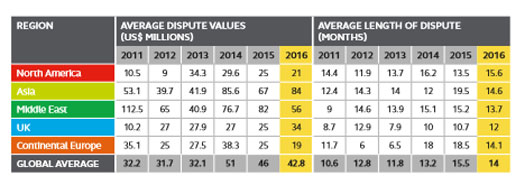Update: [Arcadis Contract Solutions 2018 Report]
Arcadis Contract Solutions released their Global Construction Disputes 2017 Report – Avoiding the same pitfalls. The 30-page report offers insight into the global construction contract landscape with recent stats and trends about constructions disputes.
According to Arcadis, in 2014, the most common cause of disputes was a failure to properly administer contracts. In 2016, this remains as the number one cause if disputes.
The study found that in 2016, the issue with employers, contractors and subcontractors failing to understand and/or comply with their contracted obligations have moved up in the ranks of dispute causes from last year.
Causes for Disputes (Ranked from Highest to Lowest):
- Failure to administer the contract
- Poorly drafted or incomplete and unsubstantiated claims
- Failure to understand and/or comply with its contractual obligation by the employer/contractor/subcontractor
- Errors and/or omissions in the contract document
- Incomplete design information or employer requirements
Arcadis reports that their was an increase in joint venture related differences, as it accounts for 32.2% of disputes.
The research found that the average value of disputes decreased from the previous year:
- The highest value of a dispute that took place in 2016 was worth $2 billion US compare to the value in 2015 of $2.5B US
- The Global average value of disputes was $42.8 million US compared to the value in 2015 of $46 million US
- The global average length of disputes has dropped to 14months from 15.5 months in 2015

Direct Influential factors the disputes:
- Commodity and currency volatility
- Legacy effects of renders priced in the immediate aftermath of the financial crisis and the ensuing economic recession
- Rising global cost base and strain upon the supply chain
- Scarcity of labor and professional staff
- Significant reduction in the oil and natural resources price that has caused a radical rethink of strategy and delivery across the major programs
<h3
The top methods ranked in the report by Arcadis are:
- Party-to-party negotiations
- Arbitration
- Mediation
The research was derived from disputes that the company handled in 2016 and relevant industry experts. It puts a spotlight on the major causes of disputes and how they were resolved in North America, Asia, Middle East, Continental Europe and the UK.
Highlighted below in the graphs are the cost and length of time it took to resolve the global construction dispute based on the geographical regions.
North America

The most common causes of disputes were:
- Errors and/or omissions in the contract document
- Poorly drafted or incomplete/unsubstantiated claims (this is new in 2016)
- Failure to properly administer the contract
The common method of resolving these issues was party to party negotiation (Remained the same).
—
Asia

The most common causes of disputes in Asia were:
- A failure to properly administer the contract
- Poorly drafted or incomplete/unsubstantiated claims
- Failure to serve the appropriate notice under the contract (This new in 2016)
The common method of resolving these issues was Arbitration (changed from party to party negotiation).
—
Middle East

The most common causes of disputes in Asia were:
- A failure to properly administer the contract
- Poorly drafted or incomplete/unsubstantiated claims
- Employer/contractor/subcontractor failing to understand and/or complying with it’s contractual obligations. (This new in 2016)
The common method of resolving these issues was party to party negotiation.
—
United Kingdom

The most common causes of disputes in Asia were:
- A failure to properly administer the contract
- Poorly drafted or incomplete/unsubstantiated claims
- Employer/contractor/subcontractor failing to understand and/or complying with it’s contractual obligations. (This new in 2016)
The common method of resolving these issues was Adjudication (contract or ad-hoc) which is new (Changes from Party to party negotiation).
—
Continental Europe

The most common causes of disputes in Europe were:
- A failure to properly administer the contract
- Conflicting party interests: (subcontractor/main contractor/Employer) or JV partners
- Employer/contractor/subcontractor failing to understand and/or complying with it’s contractual obligations. (This new in 2016)
The common method of resolving these issues is Party to party negotiation with a new one being expert determination coming in second.
Summary
Overall the findings have seen a positive outlook on the global growth, however nothing is ever linear. The time It takes to resolve a dispute and the value of these disputes have decreased, but with uncertainty in the market, it is always good to keep these key factors in mind so you can spot any issues and avoid them before it becomes serious problem.
EDITOR’S NOTE: This post was originally published July 2015 but has been updated and revamped for accuracy.
For all of the details, read the full report here – Global Construction Dispute 2017


